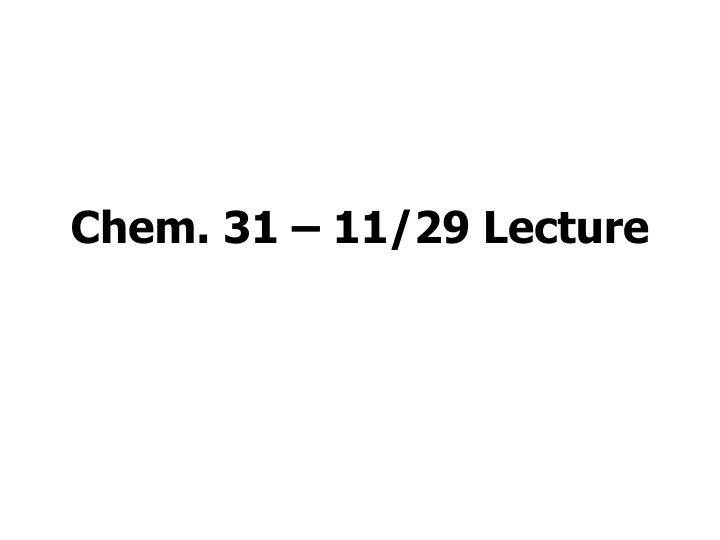
Acid Base Equilibria: Weak Base Problems, Buffer Solutions, and Importance
Explore the concepts of weak bases, buffer solutions, and their significance in maintaining constant pH levels. Learn how to set up problems using the ICE method, calculate pH for weak acid/base solutions, and understand the usage of buffers in various analytical techniques. Discover the Henderson-Hasselbalch Equation and the role of buffers in keeping species ratios constant.
Download Presentation

Please find below an Image/Link to download the presentation.
The content on the website is provided AS IS for your information and personal use only. It may not be sold, licensed, or shared on other websites without obtaining consent from the author. If you encounter any issues during the download, it is possible that the publisher has removed the file from their server.
You are allowed to download the files provided on this website for personal or commercial use, subject to the condition that they are used lawfully. All files are the property of their respective owners.
The content on the website is provided AS IS for your information and personal use only. It may not be sold, licensed, or shared on other websites without obtaining consent from the author.
E N D
Presentation Transcript
Announcements GC Lab Due Today Co/Cr Lab grading delay due to problem not with grader (thanks for your patience) Today s Lecture Chapter 9 Acid/Base Equilibria The weak base problem Buffers
Acid Base Equilibria Weak Base Problem: As with weak acid problem, ICE approach can generally be used (except when [OH-] from base is not much more than [OH-] from water) Note: when using ICE method, must have correct reaction Example: Determine pH of 0.010 M NH3solution (Ka(NH4+) = 5.7 x 10-10, so Kb= Kw/Ka= 1.75 x 10-5) Reaction NH3+ H2O NH4++ OH- Go over on board
Acid Base Equilibria Weak Acid/Weak Base Questions: A solution is prepared by dissolving 0.10 moles of NH4NO3into water to make 1.00 L of solution. Show how to set up this problem for determining the pH using the ICE method. A student is solving a weak base problem for a weak base initially at 1.00 x 10-4M using the ICE method and calculates that [OH-] = 2.4 x 10-8M. Was the ICE method appropriate? The pH of an unknown weak acid prepared to a concentration 0.0100 M is measured and found to be 3.77. Calculate and Ka.
Acid Base Equilibria Buffer Solutions: Question: Was the ICE Problem set up needed? Answer: No. The assumption of x << [HA], [A-] is valid for all traditional buffers Traditional Buffer Weak acid (3 < pKa< 11) Ratio of weak acid to conjugate base in range 0.1 to 10 mM+ concentration range
Acid Base Equilibria Buffer Solutions: Since ICE not needed, can just use Ka equation Ka= [H+][A-]/[HA] = [H+][A-]o/[HA]o (always valid) (valid for traditional buffer) But log version more common pH = pKa+ log([A-]/[HA]) Also known as Henderson-Hasselbalch Equation
Acid Base Equilibria Buffer Solutions: Why are they needed?/useful? The main reason is to keep the pH constant so that the ratio of species of acids and bases is constants Some examples: in water hardness titration, we want [Y4-]/[Y]total constant so sample pH won t affect results spectroscopy: Beer s law only applies to single species (e.g. separate laws for HIn and In-) chromatography: at pH = 2, benzoic acid is a molecule and retained (reversed-phase HPLC)
Acid Base Equilibria Buffer Solutions: Ways to make buffer solution: Mix weak acid and conjugate base (done in making reference solution for soda ash lab) Add strong base to weak acid (weak acid must be in excess) this converts some of the weak acid to its conjugate base Add strong acid to weak base (weak base must be in excess) this converts some of weak base to its conjugate acid
Acid Base Equilibria Example Problems: How many moles of hydroxyl ammonium chloride (HONH3+Cl-) needs to be added to 500 mL of 0.020 M HONH2to obtain a buffer solution with a pH of 6.20? The pKafor HONH3+is 5.96. What is the pH of a solution made from mixing 400 mL of 0.018 M CH3CO2H (pKa= 4.75) with 100 mL of 0.024 M NaOH? (assume additive volumes)
Acid Base Equilibria Example Qualitative Question: Which of the following mixtures will result in a traditional buffer: 0.010 M CH3CO2H+ 0.014 M KOH 0.014 M NH4Cl + 0.010 M KOH 0.020 M NH2CH2CH2OH + 0.010 M NaOH 0.010 M Na2HPO4+ 1.0 x 10-4M Na3PO4 NH2CH2CH2OH is a weak base
